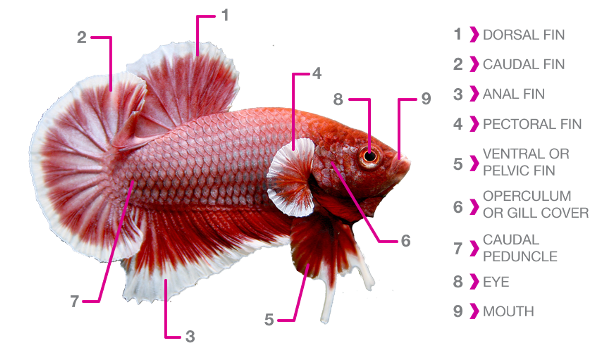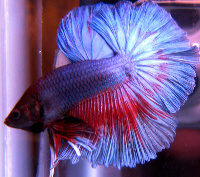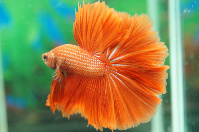 Betta fish (betta splendens)
is one of the much-loved ornamental fish.
It is a fresh water fish that many have encountered in some countries of
Southeast Asia, including Indonesia, Thailand, Malaysia, and Vietnam. This fish
has a unique shape and have characters tend to be aggressive in defending its
territory.
Betta fish (betta splendens)
is one of the much-loved ornamental fish.
It is a fresh water fish that many have encountered in some countries of
Southeast Asia, including Indonesia, Thailand, Malaysia, and Vietnam. This fish
has a unique shape and have characters tend to be aggressive in defending its
territory.
The Betta is a beautiful
fish that is somewhat tolerant to poor water quality. It is easy to breed in an
aquarium and is relatively inexpensive. While these facts add up to make it a
good beginner's fish, the real success of the Betta resulted because it was
sold as a novelty. These fish were displayed in a glass vase where a large
water plant with an intricate root system filled most of the vase. The problem with
Betta is, that these fish are extremely hardy, they still cannot survive
without their basic needs being met, and if left in these suboptimal
conditions, they will die. In fact, the complete number of Bettas sold every
year is proof that most of these fish do not survive very long, and are
frequently replaced. If every Betta survived to their minimal normal life span
of at least two years, the total sales would be a fraction of what they
currently are.
These fish are generally divided into three categories,
betta fish ornamental, betta fish for fight, and wild betta fish. When the
contest, these fish were given some extra treatments, like extra food and
special doping to strengthen the body color of the betta fish in quarantine.
Biology
Basically both male and female Bettas have the same anatomy. They
have a cylindrical form with the front part of the body narrowing to an
imaginatively compressed shape. Particularly in the male Betta, the pelvic fins
are quite long and extended. The dorsal
fins inserts behind the midpoint of the back, and have varies in length from short
to moderate. In domesticated male Betta splendors, this fin can be overstated
into a huge float. The anal fin is long and when splayed near the pectoral fin
insertion, and it billows out like a large fan, as the same way of caudal fin.
When at rest, both fins hang down, giving the outward show of long folded hangings.

As a Betta ages, his tail and fins grow longer and heavier,
causing him to become sluggish. He will become tired with his 'blowing tail.' and
he loses it only to have it grow back with some discoloration and unevenness.
However, the loss of the heavy tail rejuvenates him.
Both male and female Betta displays the beard, which is the casing
under the gill plate cover, when they are flaring, although the female's is
considerably smaller. Without having the ability to blink, the Betta's eyes
protrude. Their mouths are particularly fascinating with rows of tiny pointed
teeth and powerful strong jaws. They are perfectly designed and positioned to
both devour and to blow bubbles. What is another interesting about them is the
way the male Bettas gently carry the eggs in their mouths without damaging them
on their sharp teeth.
The internal organs of the Betta splendens, which include the
brain, heart, stomach, liver and spleen, are mostly located between the head
and the beginning of the anal fin. The lower half of its anatomy is flesh,
spine and the swim bladder. Between these anatomical features and specific
behavioral characteristics, today's Bettas can unquestionably be classified as
members of the suborder Anabantoidei.
Colors
The Betta has been breed in many different types, by having
a variety of different colours, colour patterns and tail forms. The selective
breeding began in S.E. Asia long ago, with breeding of the Plakat Morh, the true
Fighting Fish of Thailand, Plakat Khmer, the Cambodian colour form, and the
Plakat Cheen, the long-finned, ornamental variety. Modern breeding programs have greatly
extended the range of colours, fin types and patterns so that many combinations
exist. These all derive from the Plakat
Khmer and Plakat Cheen.
Solid Colors: Cellophane, white opaque, yellow, orange, red,
steel blue, green, black etc.
Bi-Color: Cambodian, green or
blue Cambodians, chocolate
Betta with Patterns: butterfly (BF), marble, piebald